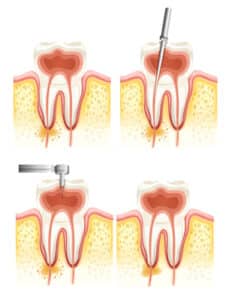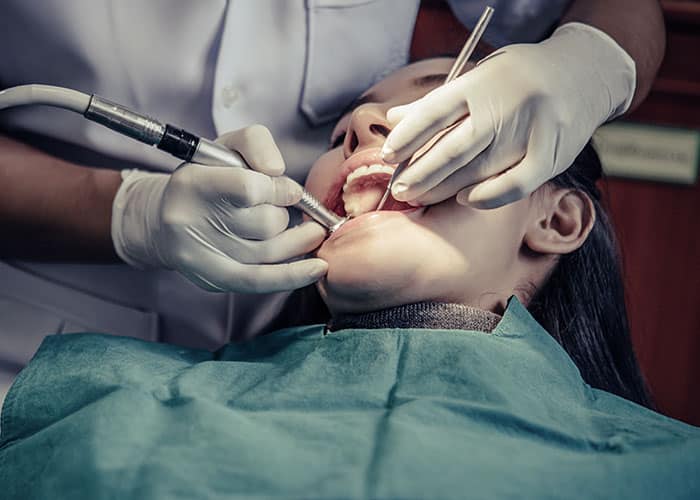You Might Need a Root Canal
If you’re reading this, it’s possible you need a root canal. Root canal therapy is used to treat severe tooth problems that without intervention could result in the loss of the tooth. Often times the tooth is badly infected or damaged, often caused by poor hygiene. A doctor will typically choose to perform a root canal procedure when the nerve of the tooth becomes infected or the pulp becomes damaged. The dentist will remove the nerve and pulp of the tooth, clean the inside, and seal it.
While root canals have a reputation for being painful, the reality is that they are actually more painful prior to being treated than they are during and following treatment. Because root canals are used to correct many serious dental problems, most patients truly report more pain prior to the procedure than the actual procedure itself. Root canals begin with the removal of the dental pulp.

Determining if You Need a Root Canal
Dental Pulp
Dental pulp is the soft area lying within the middle of the tooth. The tooth’s nerve is within the roots of the tooth, also known as the legs. Root canals travel from the tip of the tooth’s root into the pulp chamber. The pulp chamber contains blood vessels and connective tissue. The nerve’s role is nonessential after the tooth has emerged through the gums and only provides sensory function of heat or cold. The daily functioning of the tooth is not affected by removal of the nerve during a root canal procedure.
When nerve tissue or pulp is damaged, it deteriorates and bacteria may multiply in the pulp chamber. Due to this fact, nerve tissue and pulp is removed during a root canal to ensure this never happens following the procedure. The bacteria and decaying material otherwise are capable of causing an infection or abscessed tooth. An abscess is a pus-filled pocket that develops at the end of a tooth’s root and causes complications in health and functionality. An abscess is capable of causing bone loss, drainage issues, and swelling which may even spread outside the mouth.
What Necessitates a Root Canal?
A root canal often becomes necessary when the nerve and pulp become inflamed, irritated, and infected through multiple dental procedures, a chip in the tooth, deep decay or infection caused by factors including bad hygiene, large fillings, and other causes.
What Signs Indicate the Need for a Root Canal?
Some common signs that a root canal may be necessary include:
- Severe toothaches
- pain associated with chewing or applying pressure to the teeth
- Prolonged sensitivity to hot or cold temperatures, particularly after heat or cold source is removed
- Swelling and tenderness in the gums
- Discoloration of the tooth
- Recurring or persistent pimples on the gums
While sometimes no symptoms are present, your doctor may be able to notice signs of hidden problems through a dental X-ray or regular exam.
The Root Canal Procedure
A root canal procedure will be performed by either a dentist or an endodontist. An endodontist is a dentist who specializes in the causes, diagnosis, prevention, and treatment of diseases and injuries of the nerves or dental pulp in the teeth. Depending on your unique situation, you will be referred to either one or the other. Your regular dentist can advise you of which option is best.
Generally, during a root canal procedure, the first step is an X-ray to check for signs of infection in the surrounding bone and also to determine the shape of the root canals. Following the X-ray, local anesthesia is used to numb the area near the tooth. Sometimes it may not be necessary if the nerve is dead, but the anesthesia may still be used to numb the area and allow the patient to feel more relaxed during the procedure.
To keep the area dry, a rubber dam will be placed around the tooth. Following the dam placement, a hole will be drilled into the tooth to access the pulp, bacteria, decayed nerve tissue, and other debris so that it may be removed from the tooth. Root canal files are used in sequence of increasing diameter to scrape and scrub the sides of the root canals, cleaning out all the necessary contents. Water and sodium hypochlorite is used to periodically flush away the various waste materials.
Sealing the Tooth or Teeth
Once cleaned, the tooth is sealed. Sometimes the sealing occurs immediately, other times it may happen a week or so following. When a tooth is sealed later, usually it is due to infection so medication may be used in the interim to kill off the infection before sealing. Depending on the specific nature of the root canal and why it was performed, oftentimes a crown, a crown, and post, or other restorative methods may be used to further strengthen the tooth.
Following the Procedure
As mentioned previously, the majority of pain is experienced prior to the procedure. Following the procedure, recovery is usually easier because the pain that was once experienced, often severely, is now relieved. Because oftentimes a root canal is not always completed in one visit, it’s recommended that if you are awaiting a crown or an infection to clear up before the tooth is sealed, you minimize chewing on the tooth that is under repair.
Sensitivity is normal for the first few days following treatment due to natural tissue inflammation. Root canals are highly successful with a general 95% success rate.
Choosing a Dentist for Root Canal Procedure
It’s important to choose a professional dentist for your root canal procedure. City Dental Centers is happy to offer professional, reliable dentists to ensure your treatment is safe and successful. Living with pain or discomfort from a tooth that needs repair can often be resolved with a root canal procedure, so feel free to contact us with your questions or concerns.
Convenient Dentist Offices in Southern California
Doctor Sam Shahovesi and the team at City Dental Centers are here to provide our patients with the best dental services and dental surgeries for children and adults of all ages. From toddlers to seniors, City Dental Centers offers six convenient dentist offices in Southern California. We even have a dedicated children’s dentist office, City Dental Kids & Braces, to cater to the special physical and emotional needs of children.
Whether you need checkups, x-rays, braces, bonding, teeth whitening, sealants, oral cancer screenings, root canals, crowns, bridges, implants, or tooth extraction, City Dental Centers is here to make the process as easy and comfortable as possible.
Contact The Nearest Dentist to You
Ready to experience the best dentists in Los Angeles? Choose one of the convenient dental offices we have surrounding LA. We have dental practices in Azusa, Corona, Lake Forest, Montclair, Pico Rivera, and West Covina. You can call our main line at (888) 624-8933 or reach out to an office directly with the information below. We’re so happy you’ve chosen City Dental Centers. We can’t wait to help you along your dental journey and brighten your beautiful smile!
Dentist in Azusa, CA
Location: 483 S. Citrus Ave. Azusa, CA 91702
Phone: (626) 966-3400
Dentist in Corona, CA
Location: 161 McKinley St. STE 102, Corona, CA 92879
Phone: (951) 737-3746
Dentist in Lake Forest, CA
Location: 24602 Raymond Way #210, Lake Forest, CA 92630
Phone: (949) 461-5800
Dentist in Montclair, CA
Location: 5182 Moreno St, Montclair, CA 91763
Phone: (909) 295-3477
Dentist in Pico Rivera, CA
Location: 9400 Whittier Blvd, Pico Rivera, CA 90660
Phone: (562) 949-2526
Dentist in West Covina, CA
Location: 154 Plaza Dr, West Covina, CA 91790
Phone: (626) 962-1722
